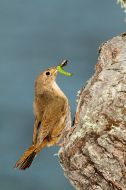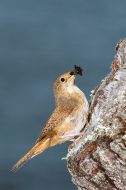House Wren
Ratona Común
Troglodytes ĉdon
Length: 125mm. Sexes alike. Bill greyish brown with base of mandible grey; iris dark brown; upper parts of head, hind neck, upper and lower back uniform brown; rump and uppertail coverts cinnamon brown with inconspicuous whitish markings; rectrices cinnamon with blackish barring; throat, foreneck, breast and belly whitish brown; flanks light brown slightly cinnamon; undertail coverts cinnamon brown. Wing coverts as back; remiges: tertiaries and secondaries cinnamon with fine blackish barring, primaries dark brown. Legs grey. Average weight: 13g. Habitat and behaviour: this species dwells in all kinds of environments, from hilltops to seashores. The House Wren is one of the most charming and friendliest birds that live close to man. Very tame and restless, it is found in the undergrowth including vegetable gardens, always seeking insects and small invertebrates that make up its diet. Markedly territorial, this bird sings from an exposed perch, repeating its highly melodious and elaborate song over and over; however, the alarm call is harsh. It is usually seen with its tail cocked. The nest is concealed in holes in trees and sheltered spots. Plant fibres, pieces of wool and feathers are used. The eggs, up to six in number, are white with a soft pinkish hue and reddish speckles all over the surface. Range: this species is widespread in Patagonia, where the race Troglodytes ĉdon chilensis occurs. On Islas Malvinas, the race Troglodytes ĉdon cobbi, endemic to the archipelago, is found.
Illustrated Handbook of the Birds of Patagonia
Kindless: Kovacs Family
|










